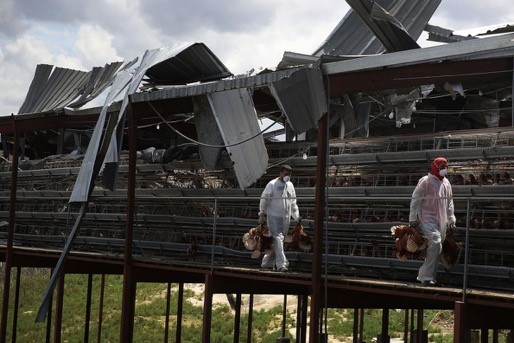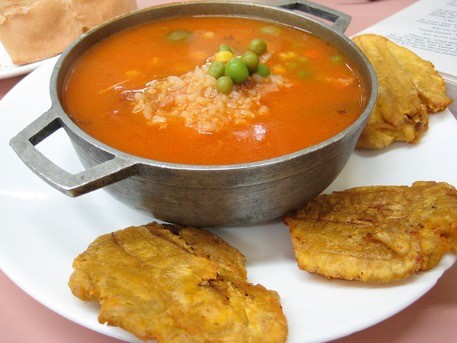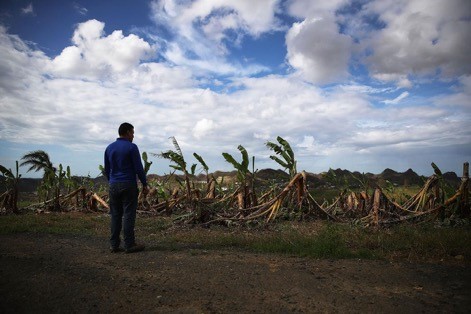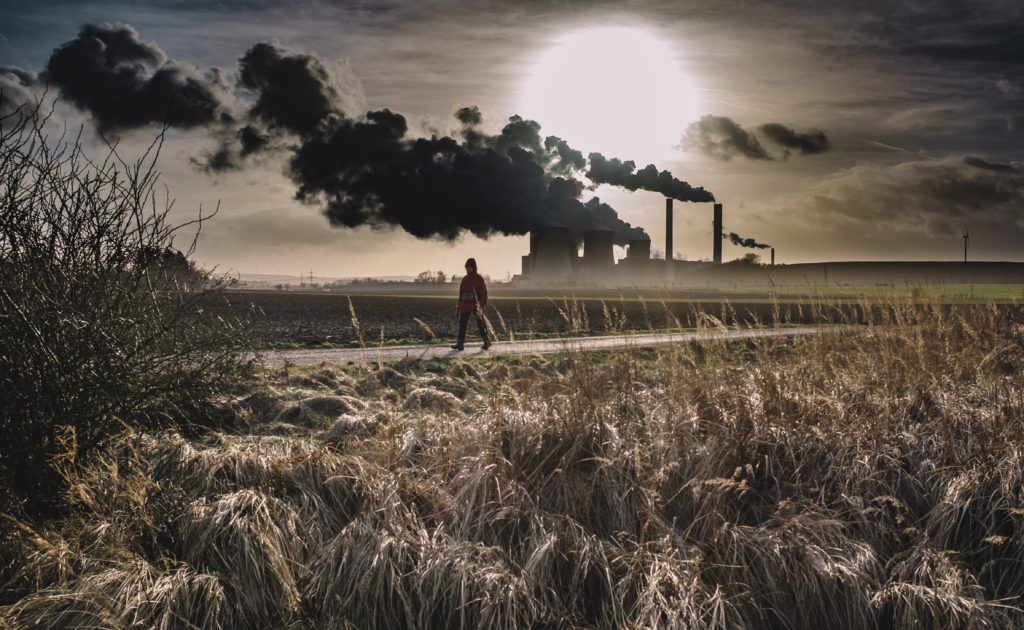
Our Climate Curriculum Disruption series will highlight projects completed by New School students during our week-long, university-wide curriculum disruption, interrupting “business as usual” and turning our attention to climate change and its implications, particularly the unequal and devastating impacts on the most vulnerable and least responsible communities around the globe.
Puerto Rican Culinary Culture & Climate Change
By Phoebe Tran
Food is inextricably tied to climate change. Erratic temperatures, unpredictable rainfall patters, shorter growing seasons and increased frequency of extreme weather will not only affect its production, but also its diversity, accessibility, nutritional value and place-based culinary cultures that it represents. The following case study looks to Puerto Rico, an unincorporated territory of the United States that is in the midst of developing a plan for resiliency in the aftermath of Hurricane Maria and impending climate change risks. I provide a brief overview of the culinary history of Puerto Rico, which reveals a modern day food system rooted in colonial trade.
The island’s culinary culture is now at risk of economic and environmental constraints. Further groundwork needs to be done in order to better understand how vulnerable communities are responding and adapting. Efforts must be made to learn from their strategies to serve as a model for other areas also on the frontlines of climate change.
Puerto Rico
The archipelago of Puerto Rico contains its main islands and a number of smaller ones, two of which are inhabited year-round (Wikipedia). It is situated in the northeastern Caribbean Sea, 1,000 miles southeast of the US state of Florida. The island is largely composed of mountainous and hilly terrain, coastal areas, lakes and rivers. A fourth of the island is covered in steep slopes formed by powerful tectonic forces that occurred over millions of years, occasionally causing earthquakes. Northward-flowing rivers are used for the supply of municipal water, hydroelectricity and irrigation for agriculture (Matthews, Wagenheim & Wagenheim, 2018). The island’s tropical climate and surrounding bodies of water allows it to inhabit biodiverse plant and animal life.
Despite allowing farmers to grow food year-round, Puerto Rico imports 80% of its food supply (Charles, 2017). The formation of its culinary culture can be best understood through the lens of Cruz Migel Ortíz Cuadra, author of Eating Puerto Rico: A History of Food, Culture and Identity. In his book, he investigates the formation foods that have come to represent Puerto Rican food. Specifically, rice, beans, corn, cassava, sweet potatoes, plantains and bananas, salted codfish, pork and beef have a place in familiar dishes and marketplaces, evoking nostalgia for home cooking in Puerto Ricans born before and during the 1950s. Despite Puerto Ricans’ identification with these foods, Cuadra raises a series of questions that further confound the reader: Why is rice grown and eaten if it is not native to the agricultural region? Under what circumstances was codfish introduced if it is not fished in warm waters like the Caribbean, where several other fish species are found in abundance? Why is it that Puerto Ricans now eat so much meat? Why were kidney beans recognized as being superior to other beans when they yielded the smallest crop, were the most costly and had the least amount of nutritional value?
Cuadra explains, “[these ingredients] achieved their status in a preindustrial food-consuming context dominated by farming, hunting, gathering and domestic animal raising, on the one hand, and the dietary limitations imposed by rigid exportation and importation markets, on the other. The exportation of food products obeyed a monoculture and their importation followed a very restricted, colonial model” (5) wherein changes in the basic diet occurred slowly because of the appearance of a new food or a structural transformation. The decades from the 1960s to the new millennium saw a much more transformative shift in Puerto Rican’s culinary landscape—higher income levels and increased availability of food commodities increased rates of obesity, the homogenization of mass food production and cross-cultural exchanges created a distinctly urban food culture; and the emergence of an unchecked fast food restaurant culture all took place against the backdrop of plateauing agricultural productivity and a disproportionate dependence on food imports. While Puerto Rican cuisine is rooted in the cooking traditions of Europe, Africa and the native peoples of the Caribbean known as Taínos, its food culture transcends the boundaries of the island to incorporate a diverse range of other cuisines. In the late 19th century, Puerto Rican cuisine began to heavily incorporate ingredients imported from the United states.
Some trace the dependence back to the island’s history as a Spanish colony, when native farms gave way to sugar and coffee plantations. While cash crops were exported back to Europe, food was imported to supply and sustain its people. As Javier Rivera Aquino, Puerto Rico’s former secretary of agriculture, would state, “They were taught to produce what they don’t consume, and they were taught to produce what they consume” (Charles, 2017). Puerto Rico’s urban food culture today does not land far from its colonial past. The size of its land and number of farmers cannot outcompete large-scale food producers in the United States (Charles, 2017), and its reliance on the shipping industry to bring in food to the island makes it especially vulnerable when cut off due to extreme changes in the climate.
While a new wave of chefs and farmers interested in re-localizing sources of food has been taking shape in Puerto Rico, the grassroots movement to build a local supply chain is an undeniable challenge when unpredictability is the new normal in a place so vulnerable to climate change. More recently, the ongoing struggles of Puerto Ricans after being hit by Hurricane Maria on September 20th, 2017 became a call to action for local communities as well as those living abroad. The Category 4 storm wiped out 80% of the island’s crop value in a matter of hours. Farmers expected the recovery period to take 10 months to a year to recover. Some were forced to import goods in order to keep their businesses running until the next harvest (Moreno, 2017). Despite being wiped out by the hurricane, local food activists have spearheaded the revitalization of Puerto Rico’s food movement that was gaining traction before the storm hit. Efforts are being made to create a national sustainable farming proposal plan for Puerto Rico (Yoder, 2017). Though positive forces like these are guiding Puerto Rico to recover and grow stronger, the environmental conditions that the island will continue to face are a cause of apprehension to anyone who understands the severity of climate change effects.
The US Environmental Protection Agency anticipates sea levels around Puerto Rico to rise one to three feet in the next century. There will be an increase in heavy rainfall and hurricane wind speeds, putting both coastal and inland areas at risk of flooding. Warmer temperatures also put the island at risk of drought, putting both agricultural productivity and human health at risk. Furthermore, acidification of the ocean is severely harming Puerto Rico’s marine ecosystems and fisheries (EPA 2017). Many of the core foods that make up Puerto Rican’s food culture—rice, beans, corn, cassava, sweet potatoes, plantains and bananas, salted codfish, pork and beef—are at risk of being lost as farms and plantations are razed and flooded by storms and animals put under extreme environmental stress. What will happen to Puerto Rico’s culinary culture in the face of climate change? While Cuadra references the various socioeconomic shifts that occurred in Puerto Rico’s historical culinary narrative, his closing sentences draw parallel ruminations to the resilience and evolutionary nature of gastronomic traditions in the face of climate change as well: “…to invent and celebrate culinary traditions…is not to nod stubbornly toward the past but to honor a more complex reality, the reality that…repertoires of food and diet travel a considerable distance and get defined, shaped, and remade by a host of influences and factors imposed from both within and without. They come to be what they are not in some static, frozen way but because they are exposed and receptive to constant change” (260).
The following recipes below are chosen for being a mainstay in Puerto Rican cuisine. They are presented with visual and audial reflections of how climate change may alter its future.


https://www.youtube.com/watch?v=aItXJGWy7QM&t=13s
Top: Workers sort the live chickens from the dead ones at the Corporacion Avicola Morovis, Inc. Flores Ortega says the lessons learned from Hurricane Maria will help the industry build with more resiliency in the future.
Photograph by Joe Raedle, Getty (National Geographic, 2017)
Bottom: Asopao de pollo con tostones.
Photo by Tara Laska (Flickr, 2007)
Video: Puerto Rican Asopao (Youtube, 2012)
Asopao de Pollo
Adapted from El Boricua: A Monthly Bilingual, Cultural Publication for Puerto Ricans
Serves 6
“The name is given to various soupy preparations of rice, which have been a mainstay in Puerto Rican rice cuisine…At one time, asopa’o played a key role in social and community life as a dish that was served at receptions, farewells, and family celebrations, or to mark rites of passage. It may have originated in poverty and necessity—people with little food at hand could bring a relatively substantial dish to the table” (Cuadra, p.265).
Chicken Marinade
1 whole chicken, cut into pieces
½ tsp oregano
salt & black pepper
olive oil
Sofrito
3 garlic cloves, pressed
2 peppercorns
2 medium onions, peeled
2 sweet chili or banana peppers
5 cilantro leaves or 7 sprigs of cilantro
3 T olive oil
Asopao
1 ½ cups short-grain rice
½ cup tomato sauce
8 cups water or chicken stock
1 cup sweet peas
Garnish
½ cup roasted pimento peppers
1 cup asparagus tips
- Marinate the chicken with salt, pepper, oregano and olive oil and set aside for at least 30 minutes.
- In the blender, purée the garlic, onions, peppercorns, chili peppers, culantro and sweet peppers and olive oil.
- In a large caldero, sauté the sofrito for 5 minutes over medium-low heat then set aside.
- Brown the chicken pieces to seal in their flavor, then add the sofrito, tomato sauce and chicken stock or water and bring to a boil. Cover, reduce heat and simmer for 10-15 minutes.
- Rinse the rice under cool running water until it runs clear. Drain the rice and stir into the soup pot. Raise the heat and bring to a boil once more. Reduce heat to medium and cook uncovered for 20 minutes, stirring occasionally.
- Add the peas and cook for an additional 5-10 minutes or until the asopao reaches the consistency you prefer.
- Heat the sliced pimentos and the asparagus in their juices. Drain and use to garnish each plate of asopao.
- Serve alongside tostones.

https://www.youtube.com/watch?v=7IZtZfz9DI8
Top: While some crops, such as root vegetables, were able to withstand the harsh winds of Hurricane Maria, larger plants like papaya and coffee were devastated. Carlos Flores Ortega, Secretary of the Department of Agriculture for Puerto Rico, says banana trees, like those seen here, were completely lost to the hurricane that rattled the archipelago on September 20.
Photo by Joe Raedle, Getty (National Geographic, 2017)
Bottom: Traditional Puerto Rican Pasteles
Photo by Juan Silva, Getty (The Spruce)
Video: Pasteles (Youtube, 2014)
Pasteles
Makes 18 servings
Masa (Dough) *Best to do the day before for easier handling.
1 1/3 lbs yautía
3 lbs guineos verdes (savory unripe bananas)
1 lb potatoes
1 green plantain
2 T milk
¼ cup achiote oil
salt
- Boil the guineos verdes for a few minutes. When the peel begins to turn black, pull it off and grate it in the food processor.
- Peel the rest of the vegetables, rinse them and grate in the food processor.
- Add milk, oil and salt.
- Mix well, cover, and refrigerate for at least one hour.
Relleno (Filling)
¾ lb pork, coursley ground
2 T achiote oil
3 oz chopped ham
½ cup onion, minced
2 cloves garlic, minced
4 ajíes dulces, chopped
3 recao leaves or cilantro sprigs, chopped
1 cup tomato sauce
½ cup garbanzo beans
½ cup olives, chopped
1 cup roasted pimento peppers, chopped
1 tsp salt
1 tsp black pepper
1 T oregano
- Heat the oil in the caldero and cook the meat and ham for about 5 minutes over medium heat.
- Add the rest of the ingredients.
- Cook on low for approximately 25 minutes until the pork is completely cooked, then cool down.
Wrap
10 banana leaves, cut into 10” squares (can substitute with foil & butcher paper)
plantain leaves (optional)
½ cup achiote oil to grease plantain leaves or paper
string
large pot of boiling salt water
- If using banana leaves, wash and clean with a damp cloth then toast them slightly over fire.
- Grease center of the wrapper with achiote oil.
- Place ½ cup of dough and thinly spread it no more than 5” long and 4” wide.
- Place 2 ½ T of meat filling on the masa.
- Fold the wrapper in half to close the pastel. If using foil, fold the edges over until tightly sealed.
- If using leaves just fold one over the other until completely sealed, then tie with string to hold it together on each end.
- Cook the pasteles for 1 hour in the boiling water, turning them once halfway through cooking.
References
“Asopao De Pollo.” El Boricua: A Bilingual, Cultural Publication for Puerto Ricans, www.elboricua.com/asopao_de_pollo.html.
Charles, Dan. “How Puerto Rico Lost Its Home-Grown Food, But Might Find It Again.” NPR, NPR, 13 May 2017, www.npr.org/sections/thesalt/2017/05/13/527934047/how-puerto-rico-lost-its-home-grown-food-but-might-find-it-again.
Cuadra, Cruz. Eating Puerto Rico: a History of Food, Culture, and Identity. Translated by Russ Davidson, University of North Carolina Press, 2013.
Laska, Tara. “Asopao De Pollo Con Tostones.” Flickr, 24 Apr. 2007, www.flickr.com/photos/wheatland/487956183/.
Moreno, Carolina. “Puerto Rico’s Farmers Face A Long Road To Recovery Post-Hurricane Maria.” Huffington Post, 26 Nov. 2017, www.huffingtonpost.com/entry/puerto-rico-farmers-road-to-recovery-post-hurricane-maria_us_5a0f4bd9e4b0e97dffed381d.
“Puerto Rico.” Wikipedia, en.wikipedia.org/wiki/Puerto_Rico#Geography.
“Puerto Rico’s Farms Were Wiped Out. Here’s How They’re Bouncing Back.” National Geographic, National Geographic Society, 7 Nov. 2017, news.nationalgeographic.com/2017/11/puerto-rico-agriculture-destruction-resilience-hurricane-maria/.
United States, Congress, “What Climate Change Means for Puerto Rico.” What Climate Change Means for Puerto Rico, Aug. 2016.
Wagenheim, Olja J, et al. “Puerto Rico.” 17 Feb. 2018, www.britannica.com/place/Puerto-Rico.
Yoder, Kate. “Hurricane Maria Crushed Puerto Rico Farms. This Activist Wants to Grow Resilience through Food.” Grist, 24 Oct. 2017, grist.org/article/hurricane-maria-crushed-puerto-rico-farms-this-activist-wants-to-grow-resilience-through-food/.
Special thanks to Professor Andrew F. Smith, his students, and The New School Food Studies Program.


Comments are closed.